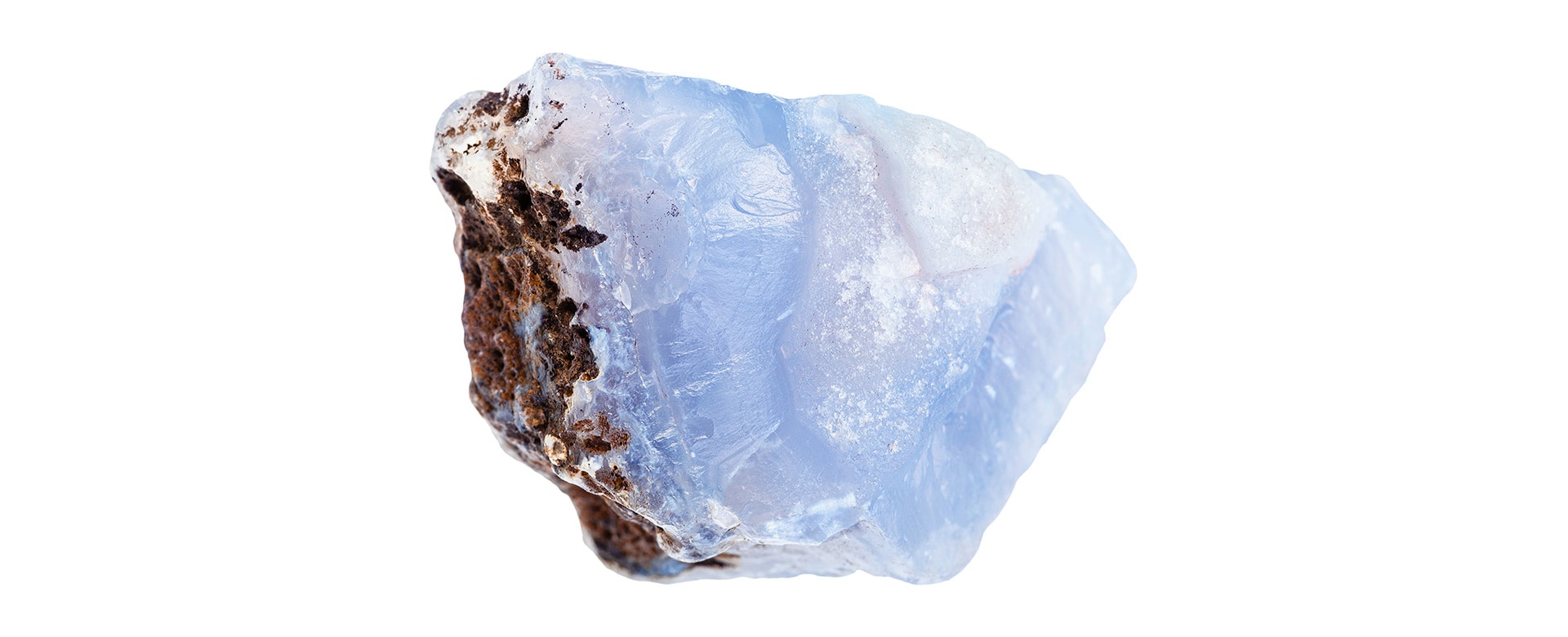Article Highlights
- Blue Chalcedony forms through a natural, slow process involving silica-rich fluids.
- The beautiful blue hue arises due to the Tyndall effect.
- Blue Chalcedony holds a rich history dating back to 2500 B.C., with origins in what’s now Turkey.
Formation and Geological Properties
Silica, one of Earth’s most abundant elements, is the mother of Blue Chalcedony. She doesn’t just birth Blue Chalcedony, but a whole family of Quartz minerals, chalcedony being one of them.
Blue Chalcedony, specifically, is a cryptocrystalline form of silica, which means it’s composed of tiny, microscopic crystals that are barely visible to the naked eye. These are densely packed together, forming this captivating stone. It’s a slow, graceful process as silica-rich fluids seep into cavities within larger rocks, depositing layers upon layers over millions of years. Mother Nature isn’t in a rush, and we’re thankful for that because her slow pace births gems like Blue Chalcedony!
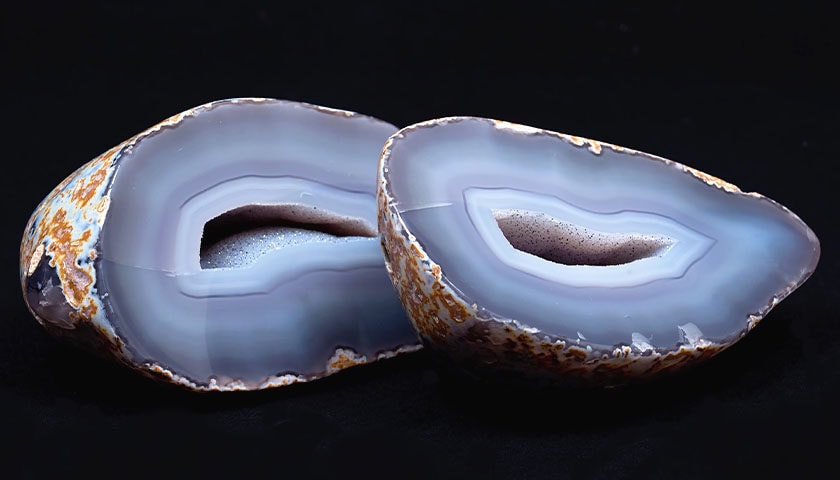
Alright, now let’s get into why this stone is, well, blue. It’s all thanks to the “Tyndall effect”. You know how sometimes the clear sky turns a brilliant blue? That’s the Tyndall effect in action. When light scatters by particles that are colloid-sized (that’s really, really small), it creates a gorgeous blue color. It’s a fantastic spectacle of nature, just like Blue Chalcedony itself!
A Stroll Down History Lane
Now that we’ve explored how Blue Chalcedony is formed, let’s turn the pages of history and learn about its past. The beautiful Blue Chalcedony on the market today primarily comes from a single region in Turkey. Imagine that – a vast portion of the world’s supply of this stunning stone, all from one place! And this isn’t a new discovery; this area has been known for its Blue Chalcedony since as far back as 2500 B.C. That’s some seriously ancient bling!
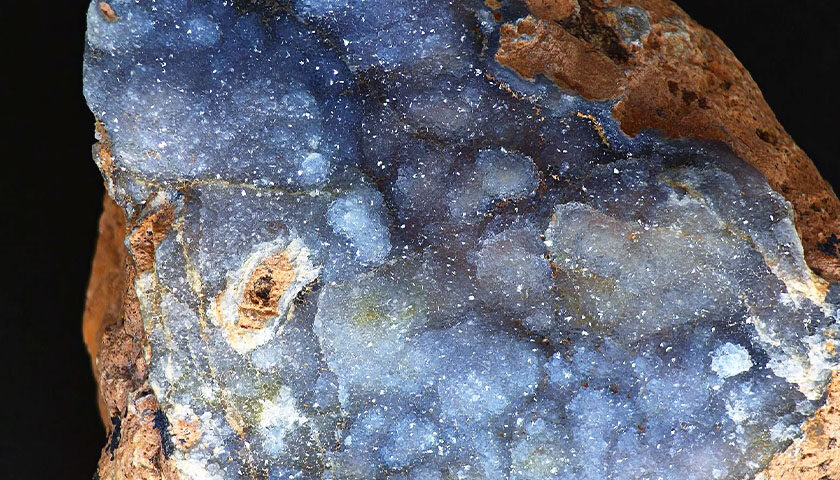
The term “chalcedony” has a history as rich as the stone itself. It’s named after the ancient seaport of Chalcedon, in Turkey. Over time, Chalcedon has evolved into the city we now know as Kadikoy. So, not only is Blue Chalcedony a geological marvel, but it’s also a historical artifact, a token from an ancient civilization.
The Magic of Blue Chalcedony

There’s something magical about Blue Chalcedony, don’t you think? Maybe it’s the calming blue hue, the result of a natural phenomenon. Or it might be the thought of those microscopic crystals, coming together over millions of years to create this breathtaking stone. Perhaps it’s the rich history, a tale of ancient seaports and civilizations.
Varieties of Blue Chalcedony
1. Blue Chrysoprase (or Blue Prase)
Behold, the alluring beauty of Blue Chrysoprase, a captivating variant of Blue Chalcedony that is indeed a sight to behold! Unveiling an unrivaled shade of blue, this gemstone is as mesmerizing as it is uncommon. Its name, Blue Prase, pays tribute to its intriguing colour, as ‘prase’ in Greek means ‘leek,’ alluding to the stone’s unique greenish-blue hue.
Blue Chrysoprase is a fascinating treat to gem enthusiasts, featuring a distinctive blend of nickel and other trace elements that render its captivating tint. Unlike the regular green Chrysoprase, the blue variant manifests a range of colours, from soft azure to deeper blues, mimicking the spectrum of tranquil seas.
The enchanting blue of Blue Chrysoprase is often enhanced by the delicate translucency of the stone, lending it an ethereal quality. Whether you’re seeking a gemstone for unique jewellery or to enhance your gem collection, Blue Chrysoprase promises a touch of nature’s best blues enveloped in pure elegance.
2. Blue Onyx
Let’s sail into the world of Blue Onyx, a bold and beautiful variety of Blue Chalcedony. A multilayered wonder, Blue Onyx portrays the dynamic aspects of life and nature. It is admired for its soothing blue hue that evokes an immediate sense of tranquility, likened to the calm of a gentle sea or the vast expanse of the azure sky.
Blue Onyx, in its most natural form, displays bands of white, grey, and blue in varying intensity and patterns, each telling a different geological tale. Its characteristic banding differentiates it from other gemstones and makes it a beloved choice for statement jewellery and artistic creations.
The bands in Blue Onyx act as a canvas for the artist, enabling them to carve, sculpt, and fashion it into diverse shapes and styles. For those who appreciate art, symmetry, and the intrigue of nature, Blue Onyx is indeed an enticing choice.
3. Blue Pietersite
Next on our journey is the dazzling Blue Pietersite, a variety of Blue Chalcedony known for its striking, stormy visual effect. Often referred to as the “Tempest Stone,” Blue Pietersite is a magnificent display of nature’s power and beauty combined.
Named after its discoverer, Sid Pieters, Blue Pietersite is characterized by its brecciated, chatoyant structure, giving it a unique, ever-changing iridescence. Its swirls and streaks of blue, gold, and grey create an optical phenomenon that is both mysterious and enchanting.
Its deep blue shade appears to shift and flow like a stormy sea or clouds, creating a captivating dynamic appearance. For those seeking an unconventional gemstone with a story to tell, Blue Pietersite is the epitome of mystic charm and natural beauty.
4. Blue Aquaprase
Stepping into the realm of Blue Aquaprase, a relatively recent addition to the family of Blue Chalcedony, we find a gemstone that is as beautiful as it is unique. The name ‘Aquaprase’ combines ‘aqua’ for its water-like colour and ‘prase’ for its green inclusions.
Blue Aquaprase’s alluring sea-green blue hue is unlike anything else in the gem world. This stone often exhibits natural, earthy inclusions, creating fascinating patterns reminiscent of underwater landscapes.
It’s a stone that resonates with nature lovers and anyone who appreciates the remarkable combinations of colour and pattern. If you’re a fan of organic gemstones with their own unique character, Blue Aquaprase is sure to win your heart!
5. Blue Damsonite
Finally, we arrive at Blue Damsonite, an exquisite variety of Blue Chalcedony with a deep blue-purple hue that sets it apart. This stone’s rich, damson plum colour is nothing short of mesmerizing and is unique to this specific variety of Chalcedony.
The allure of Blue Damsonite lies in its potent colour and velvety sheen. The stone often displays a nearly opaque, waxy lustre that adds to its visual depth and texture. It’s a gem that exudes a regal charm, making it a stunning choice for sophisticated jewellery designs.
Blue Damsonite is a testament to the remarkable diversity and beauty within the family of Blue Chalcedony. If you’re looking for a gemstone that carries an air of royalty and distinctiveness, Blue Damsonite makes for an unforgettable selection.
6. Blue Agate

As we continue our journey through the realm of Blue Chalcedony, let’s explore the enchanting world of Blue Agate. This microcrystalline quartz variant is recognized for its spectacular banding patterns and soothing, sky-blue hues, making it a staple in many gem collections.
6. 1. Blue Lace Agate

First, we’ll delve into the mystical beauty of Blue Lace Agate. This variety of Agate is truly a marvel of nature, featuring intricate, lace-like patterns swathed in soft, serene shades of blue and white. It’s like gazing into a tranquil sky adorned with fluffy, white clouds.
Blue Lace Agate’s delicate and calming aesthetic is perfect for creating elegant, understated jewellery pieces. It resonates with those who appreciate subtle beauty and the calming influence of nature’s artistry. Truly, Blue Lace Agate is a soothing lullaby in stone form.
6. 2. Holly Blue Agate
Let’s move on to Holly Blue Agate, a gemstone that wears its beauty with a touch of mystery. Known for its unique violet-blue hue, Holly Blue Agate is a gem collector’s delight. It was named after the Holly Ranch in Oregon, where it was first discovered.
Holly Blue Agate is cherished for its translucence and colour, which can range from lavender to periwinkle, often with wispy inclusions. These unique traits make it a coveted addition to any collection and a unique choice for jewellery designs that tell a story.
6. 3. Ellensburg Blue Agate
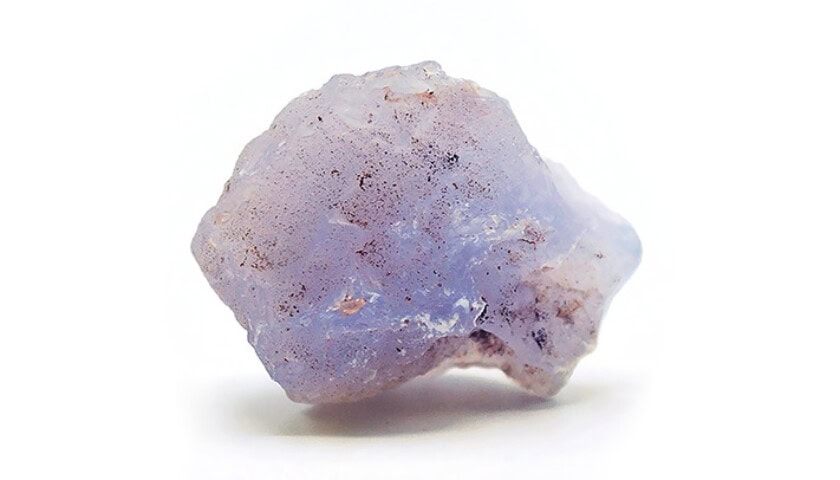
Next on our journey is Ellensburg Blue Agate, a rare variety exclusive to the Kittitas Valley near Ellensburg, Washington. This gem’s unique powder-blue hue is one of a kind, giving it the coveted status among blue gemstones.
Ellensburg Blue Agate is loved for its high translucence and varying intensities of blue colour, from pale sky blue to deep ocean hues. Its rarity and unique colour make it a collector’s gem and a brilliant choice for those seeking something truly distinctive in their jewellery.
6. 4. Blue Banded Agate
Now, let’s explore the beauty of Blue Banded Agate, an enticing variant characterized by its signature bands of blue and white. The bands’ fascinating patterns give this gemstone a captivating appearance, making it a showstopper in any jewellery piece or collection.
Blue Banded Agate comes in various shades of blue, from light to dark, and its patterned bands are nature’s artwork that lends the stone an added layer of interest and depth. It’s truly a feast for the eyes, making it a favourite among gem enthusiasts and artists alike.
6. 5. Blue Dendritic Agate
Finally, we arrive at Blue Dendritic Agate, a truly unique and intriguing variety of Blue Chalcedony. This stone is known for its dendrite inclusions, which create fascinating, tree-like patterns against the backdrop of the stone’s blue hue.
Blue Dendritic Agate serves as a canvas for nature’s art, offering a captivating display of intricate patterns that mimic landscapes or frost on a window. The blue background gives a feel of a wintery scene or a serene, moonlit night sky. It’s a choice gem for those who love the unusual and the picturesque in their gemstone collection.
7. Blue Jasper
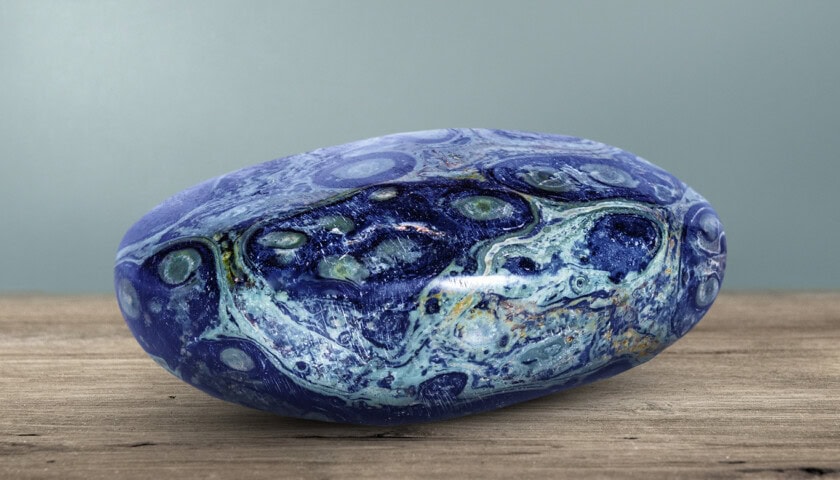
Join us now as we embark on a journey through the vivid world of Blue Jasper. This variety of Blue Chalcedony is renowned for its opacity and richness of colour. The variety of patterns and inclusions within Blue Jasper create a treasure trove of natural art.
7. 1. Blue Dalmatian Jasper
Our first stop takes us to the playful world of Blue Dalmatian Jasper. This gemstone is named after the Dalmatian dog breed due to the resemblance of its spots. While it commonly occurs in a white and black palette, the blue variant is unique and delightful, showcasing the same distinctive spotting against a dreamy blue backdrop.
Blue Dalmatian Jasper is a perfect gemstone for those who appreciate playful aesthetics and a touch of whimsy in their jewellery or gem collection. Each piece is unique, just like the spots on a Dalmatian pup, promising an eye-catching display of natural wonder.
7. 2. Blue Imperial Jasper
Next, we delve into the majesty of Blue Imperial Jasper. This stone is highly esteemed for its extraordinary quality and unique patterns. Its vibrant blue colour, coupled with unique patterns of lines, dots, and swirls, makes it a sought-after gemstone.
Blue Imperial Jasper brings a sense of grandeur and elegance to any jewellery design or collection. Its patterns are reminiscent of abstract art, allowing the wearer or viewer to get lost in its intricate design and deep blue shades.
7. 3. Blue Kambaba Jasper
Our journey now leads us to Blue Kambaba Jasper, a mesmerizing variant known for its blue-green colour and dark, mystifying circular patterns. This stone, often associated with tranquility and peace, is like gazing into a deep, calm sea.
The dark orbs against the blue-green background of Blue Kambaba Jasper make it a standout among jaspers. It’s a brilliant choice for anyone seeking a gemstone with a captivating visual narrative, like an alien landscape or an abstract painting.
7. 4. Blue Ocean Jasper
Next, we set sail for Blue Ocean Jasper, a gem that brings the serenity of the sea to your fingertips. Renowned for its varying patterns of circles, lines, waves, and specks, it depicts an oceanic scene in a range of blue hues.
Each piece of Blue Ocean Jasper serves as a snapshot of a vibrant underwater world. Its distinctive appearance makes it a favorite for statement jewellery and an enchanting addition to any gem collection, inspiring a sense of exploration and admiration for the world’s natural beauty.
7. 5. K2 Blue Jasper
Finally, we reach K2 Blue Jasper, a unique blend of blue spots against a white or grey background. Named after the K2 mountain where it was discovered, this gemstone is as rare as it is striking.
The contrast between the bright blue spots and the subdued background in K2 Blue Jasper makes it a visual treat. This gemstone invites viewers into a snowy landscape dotted with blue wildflowers, making it a distinctive choice for those seeking to capture a piece of the natural world’s stark beauty.
Blue Chalcedony Meaning and Symbolism
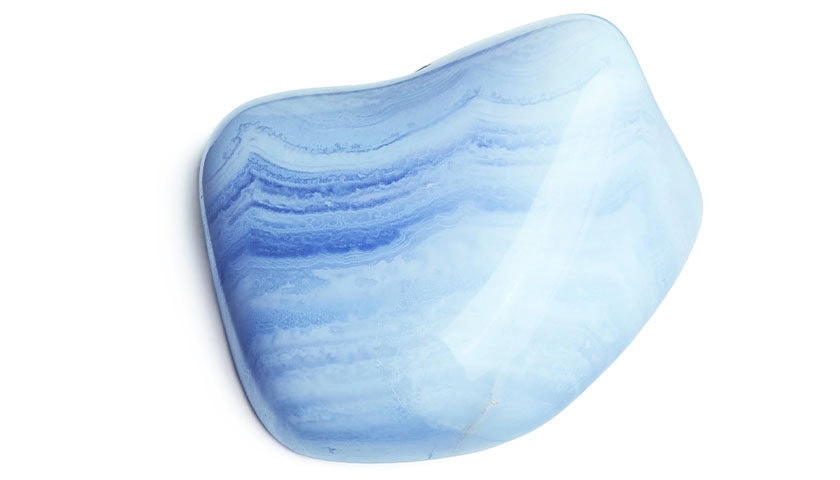
As we navigate the myriad hues and depths of Blue Chalcedony, there’s another layer worth exploring: its symbolism and meaning. Throughout history, civilizations have ascribed this enchanting gem with values that extend beyond its physical allure.
In the realm of symbolism, Blue Chalcedony is often associated with tranquility and balance. Its soothing color palette, reminiscent of a calm sea or a clear sky, makes it an emblem of serenity. It’s not just a pretty gem to behold, but also a symbolic reminder to maintain balance and peace amidst the chaos of life.
Beyond serenity, Blue Chalcedony is also a symbol of communication and brotherhood. Its name has roots in the Greek port city of Chalcedon, renowned for its lively trade and cultural exchanges. This connection to a bustling hub of communication makes Blue Chalcedony a gemstone associated with openness, exchange, and brotherhood.
In many cultures, Blue Chalcedony is cherished as a protective talisman. Its cool tones are believed to ward off negative energies and promote a harmonious environment. Whether you’re wearing it as a piece of jewelry or using it as part of your interior decor, this stone’s presence resonates with a sense of protection and calm.
Blue Chalcedony Healing Properties

A Haven for Emotional Tranquility
- Blue Chalcedony is believed to hold profound emotional healing properties.
- Its calming energy may help to dispel negative emotions and foster positive ones.
Let’s dive into this ocean of tranquility, shall we?
Waves of Calm: Emotional Healing with Blue Chalcedony
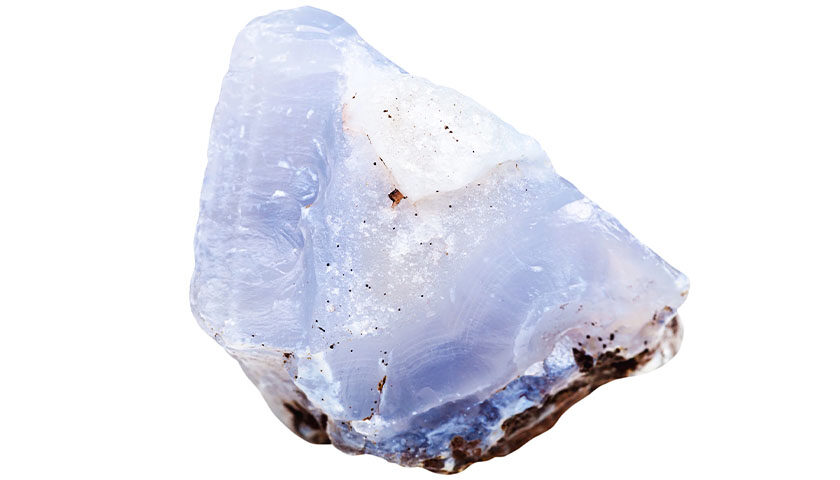
Like the serene sky or a tranquil sea, the soft blue hue of Chalcedony can soothe your senses. But, that’s just the beginning! It’s believed to extend its calming vibe into the emotional realm, making it a haven for those seeking emotional balance.
Navigating our emotional world can sometimes feel like weathering a storm. Anxiety, stress, or anger can hit like wild waves, threatening to capsize us. Blue Chalcedony is like a lighthouse in this tumultuous ocean of emotions. Its calming energy may help dispel the negative vibes and foster positivity.
It’s like having a comforting friend, who’s always there, offering a shoulder to lean on when the going gets tough. Its soothing presence can bring about feelings of peace, helping to calm an overactive emotional mind.
A Guiding Star on the Spiritual Voyage
- Blue Chalcedony is thought to aid spiritual growth and wisdom.
- It may inspire feelings of connectedness and communication on a spiritual level.
Ready to embark on a spiritual voyage? Let’s set sail!
A Beacon of Light: Blue Chalcedony for Spiritual Growth
The spiritual journey is a voyage into the unknown. It’s an exploration of the self, the universe, and everything in between. In this adventure, Blue Chalcedony can be your guiding star, offering its gentle light to illuminate your path.
Blue Chalcedony is thought to open the portals of communication, not just on a physical level but on a spiritual one. It’s like a cosmic interpreter, helping us understand the language of the universe.
Furthermore, it’s believed to inspire feelings of connectedness. In this vast universe, it’s easy to feel small and isolated. But Blue Chalcedony reminds us that we’re all part of this grand cosmic tapestry, each thread as important as the other.
Blue Chalcedony: Marveling at Its Diverse Forms

The Rough Stones: A Nod to Nature
If you’re the kind who likes to keep things raw and real, the rough stones of Blue Chalcedony are just for you. Untouched by human hands, these stones are as Mother Nature intended, unpolished, and beautifully rugged.
From a geological standpoint, rough stones reveal much about the crystal’s growth and formation. Each stone is like a puzzle piece, offering a glimpse into the geological jigsaw that spans millions of years. Not to forget, the awe-inspiring sight of the raw blue radiating from its earthy crust – it’s pure magic!
In the world of crystal healing, rough stones are believed to hold pure and powerful energy. Their unaltered form is thought to resonate strongly with natural healing vibrations. The rawness of the Blue Chalcedony rough stone, with its soothing energy, can make a beautiful and potent companion on your journey to emotional tranquility.
The Blue Chalcedony Spheres: A Perfect Harmony
For those who prefer balance and harmony, Blue Chalcedony spheres are the perfect pick. Carved into a flawless round shape, they showcase the stone’s serene blue hue from every angle.
As much as they are a testament to human craftsmanship, these spheres are also a nod to nature’s balance. They embody the perfect symmetry and harmony found throughout the natural world, from the roundness of the Earth to the circular orbits of the planets.
In the realm of crystal healing, spheres are symbols of unity, completeness, and infinity. The gentle energy of the Blue Chalcedony sphere may help bring a sense of wholeness and balance, perfect for those seeking emotional and spiritual equilibrium.
Blue Chalcedony Hearts: Love in Stone
There’s something truly special about Blue Chalcedony carved into the shape of a heart. It’s as if the stone’s calming energy is encapsulated in a symbol of love and compassion.
These heart-shaped stones make for charming keepsakes or gifts, representing a tangible piece of love. Every time you glance at the heart, you’re reminded of the gentle power of love and the tranquility that Blue Chalcedony brings.
Crystal healers often suggest heart-shaped stones to encourage love and emotional healing. A Blue Chalcedony heart, with its soothing energy, can act as a reminder to treat oneself and others with kindness and compassion.
Blue Chalcedony Pyramids: Architectural Wonders
If you’re fascinated by ancient architecture and geometry, you’ll love Blue Chalcedony pyramids. The pyramid shape, one of the oldest architectural forms, has fascinated humans for centuries. The Blue Chalcedony pyramid is a miniature embodiment of this timeless fascination.
From a geological perspective, these pyramids represent the beauty of natural elements transformed by human craftsmanship. The pyramid shape showcases the stone’s beautiful blue hue in a unique way, catching the light at different angles.
Basking in the Blue: The Charm of Wearing Blue Chalcedony Jewelry
Blue Chalcedony Necklaces: A Cascade of Calm
A necklace sits close to the heart and speaks volumes about the person wearing it. Now, imagine draping a Blue Chalcedony necklace around your neck. Feel the cool touch of the stone against your skin, its serene blue hue reflecting the light.
In the realm of crystal healing, Blue Chalcedony necklaces are believed to bring tranquility and peace. It’s as if the gentle energy of the stone cascades down from your neck, enveloping your entire being in a soothing aura.
Blue Chalcedony Rings: A Touch of Serenity
Nothing matches the intimate touch of a ring. With a Blue Chalcedony ring, you’re not just wearing a piece of jewelry; it’s like having a personal touchstone of calm. The stone’s soothing blue hue adds a delicate charm to your hands, making a subtle yet powerful style statement.
For those who delve into the healing properties of gemstones, a Blue Chalcedony ring is thought to bring emotional balance and composure, right at your fingertips.
Blue Chalcedony Bracelets: Embrace Tranquility
A bracelet is a unique piece of jewelry that accompanies every gesture, every movement of your hands. Imagine a Blue Chalcedony bracelet, a delicate strand of tranquility, gracing your wrist.
As a gem believed to promote calm and emotional balance, a Blue Chalcedony bracelet serves as a constant reminder of serenity amidst the daily hustle and bustle. It’s like having a personal slice of the calm blue sky, always within your sight.
Blue Chalcedony Pendants: Pocket-sized Peace
A pendant is more than just a decorative piece. It’s an emblem that you carry close to your heart. Picture a Blue Chalcedony pendant, its calming blue hue nestled against your chest.
In the world of crystal healing, carrying a Blue Chalcedony pendant is thought to bring a sense of peace and tranquility wherever you go. It’s your pocket-sized piece of calm, ready to soothe your senses at a moment’s notice.
Blue Chalcedony Earrings: Whispers of Calm
Earrings are like whispers of style that add a touch of personality to your appearance. Now, imagine Blue Chalcedony earrings, adding a splash of soothing blue by your cheeks.
Beyond their aesthetic appeal, Blue Chalcedony earrings are believed to radiate calming energy around your face, promoting feelings of peace and balance. It’s like having tiny droplets of tranquility, hanging by your ears, whispering calm into your day.
Blue Chalcedony Beads: Strings of Serenity
Beads have a unique allure. They’re small, yet when strung together, they create something beautiful and significant. Picture strands of Blue Chalcedony beads, each a tiny sphere of calm, coming together to create a string of serenity.
Wearing Blue Chalcedony beads is like adorning yourself with nuggets of tranquility. In the world of crystal healing, these beads are thought to offer soothing vibes, promoting emotional balance and peace.
Pricing the Sky: Understanding the Value of Blue Chalcedony
Blue Chalcedony, with its captivating celestial hue, does hold a place of reverence in the world of gemstones. Pricing this serene beauty, however, depends on several factors such as quality, size, and craftsmanship involved.
Typically, a higher quality Blue Chalcedony with excellent color and clarity can fetch prices in the range of $50 to $100 per carat. Smaller pieces and those with less intense color can go for as low as $10 per carat.
Blue Chalcedony vs Blue Lace Agate
In the lapidary world, Blue Chalcedony and Blue Lace Agate are often closely associated, and for good reason. Both are forms of quartz, with their defining blue hues ranging from pale to deeper sky blue.
Blue Chalcedony, with its uniform translucent allure, often presents a smooth, wax-like luster. Its origin stories trace back to Turkey, with some unique pieces even reaching prices upwards of $100 per carat. Its uniform, dreamy blue color presents a sense of calm and tranquility, making it a favorite amongst gem enthusiasts and healers alike.
On the other hand, Blue Lace Agate is all about the patterns. Named for its characteristic white or light blue banding, it creates a visual effect similar to delicate lacework. It’s primarily sourced from Namibia and South Africa, and typically has a price point of $10-$20 per carat, depending on the quality and intensity of its banding. Its mesmerizing patterns have long been associated with tranquility and grace, imbuing a sense of peace to those who wear it.
Blue Chalcedony vs Aquamarine
Blue Chalcedony and Aquamarine, two gemstones as reminiscent of water as they come. Blue Chalcedony, with its soft, cloudy sky-blue, and Aquamarine, whose name literally translates to ‘water of the sea’, offer their unique aquatic charm.
Aquamarine, a member of the beryl family, usually comes in a light to dark blue, often with a touch of green. Originating primarily from Brazil, but also found in countries like Nigeria and Madagascar, it’s valued for its clarity and large crystal sizes. Depending on the intensity of its color and clarity, prices can range from $100 to $500 per carat. Historically, sailors often carried Aquamarine to ensure a safe and prosperous journey across the seas.
Comparatively, Blue Chalcedony doesn’t just offer the aesthetics; it tells a story of the ancient seaport of Chalcedon. It provides a soothing blue reminiscent of a calm sky, offering a sense of tranquility to its bearers. Though it may not have the same clarity as Aquamarine, it’s its serene, inviting allure that truly makes it a gem.
Blue Chalcedony vs Blue Calcite
Blue Chalcedony and Blue Calcite, though both share a soft, appealing blue color, differ significantly in their composition and properties.
Blue Calcite, a carbonate mineral, is recognized for its soothing, light blue color and often shows a vitreous to pearly luster. It’s abundantly available around the globe, with prominent sources in Mexico and Madagascar. This common availability makes it quite affordable, with prices typically around $2-$10 per carat. It’s been associated with calming energies and is said to encourage rest and relaxation.
In contrast, Blue Chalcedony, a microcrystalline quartz, has its appeal in its translucence, offering a mystical vibe. The allure of its unique blue, coupled with its historical significance, has often made it a choice gem for many.
Blue Chalcedony vs Angelite
Blue Chalcedony, a gemstone symbolizing calmness, meets Angelite, a stone renowned for its spiritual connection.
Angelite, or blue anhydrite, presents a light sky-blue color, often with white flecks. Predominantly found in Peru, this stone has a price range of approximately $2-$10 per carat. Often associated with angelic connections, it’s believed to enhance communication and self-expression.
Meanwhile, Blue Chalcedony, with its uniform blue color and waxy luster, offers a serene and calming energy. It may not have the same angelic associations as Angelite, but its tranquil charm and unique, soft blue color make it just as enchanting in its own right.
Blue Chalcedony vs Blue Aventurine
Journey into the realm of calm with Blue Chalcedony, and step into the sphere of self-assurance with Blue Aventurine. These two stones, both bearing peaceful blue hues, serve different purposes for their bearers.
Blue Aventurine, a quartz variety, ranges from a soft to deep blue with minute sparkly inclusions. Sourced predominantly from India, it’s usually priced around $2-$10 per carat. This stone has been known to foster self-discipline and inner strength, ideal for those seeking to bolster their confidence.
Blue Chalcedony, on the other hand, is all about tranquility and composure. Its soft, inviting hue promotes a sense of calm, enabling clear communication and thoughtful action. Despite their different focuses, both stones harmoniously blend the concepts of peace and confidence.
Blue Chalcedony vs Blue Chrysocolla
Step into the world of soothing blues with Blue Chalcedony and Blue Chrysocolla.
Blue Chrysocolla, a hydrated copper phyllosilicate, is known for its bright to dark blue-green color. It’s often found in copper mining areas like Israel and the Democratic Republic of Congo. Typically priced between $5-$20 per carat, it’s been cherished as a stone of harmony, used to dispel negative energies.
In contrast, Blue Chalcedony presents a serene, smooth blue. Its calming energy complements the harmonizing traits of Chrysocolla, making these two a dream team for anyone seeking peace and balance.
Blue Chalcedony vs Blue Aragonite
Discover the mystical depths of the ocean with Blue Aragonite and the calm expanse of the sky with Blue Chalcedony.
Blue Aragonite, a carbonate mineral, exhibits a unique blue hue with a pearl-like luster. Its sources include Spain and the USA, and it can fetch prices from $5 to $20 per carat. It’s often associated with emotional healing and patience.
On the other side, Blue Chalcedony brings a tranquil energy that aids in communication and mindfulness. Its dreamy sky-blue hue brings a sense of calm, offering the perfect balance to Blue Aragonite’s deeper energy.
Blue Chalcedony vs Blue Jade
In the realm of peaceful blues, Blue Chalcedony meets Blue Jade.
Blue Jade, a variety of the jadeite or nephrite minerals, often comes in a soft to medium blue. Sourced from locations like Russia and Guatemala, it’s valued for its durability and unique color, fetching prices of around $20-$100 per carat. Traditionally, it’s been seen as a stone of peace and serenity.
Against Blue Jade, Blue Chalcedony holds its own with its uniform, soothing blue color. Its calming energy makes it the ideal companion for Blue Jade, both working together to promote peace and serenity.
Blue Chalcedony vs Blue Jasper
Last, but not least, we have Blue Chalcedony and Blue Jasper, two stones that harmoniously play a soothing melody.
Blue Jasper, a microcrystalline quartz, offers an array of blues mixed with other colors, often in banded patterns. Found globally, it’s typically priced around $2-$5 per carat. It’s believed to bring confidence and inspire courage in its bearers.
Blue Chalcedony, with its serene, even coloration, fosters a sense of calm and balance. Its tranquil energy acts as a balance to the invigorating spirit of Blue Jasper, making them the perfect duo for anyone seeking both peace and courage in their lives.
Blue Chalcedony Crystal Combinations
Blue Chalcedony and Rose Quartz: A Symphony of Calm
Let’s dive into the heart-soothing world of Blue Chalcedony and Rose Quartz. These two stones might appear distinct in color, but they share a unique harmony in their soothing vibes.
Rose Quartz, with its blush pink hue, is known as the stone of universal love. It’s all about encouraging self-love, fostering deep inner healing, and promoting feelings of peace.
Combine this with the tranquil sky-blue energy of Blue Chalcedony, and you have a perfect symphony of calm. Blue Chalcedony, with its soothing and calming energies, is believed to enhance communication and understanding.
Together, these two stones can be a potent combination. They’re like a sweet lullaby for the heart, promoting love, communication, and tranquility.
Blue Chalcedony and Zultanite: A Dance of Duality
Next, we have the unique duo of Blue Chalcedony and Zultanite. This combination is all about balance and transformation.
Zultanite, with its color-changing abilities, serves as a symbol of flexibility and adaptation. Its energy is believed to aid in making necessary changes and embracing transitions.
When paired with the serene energy of Blue Chalcedony, it’s like a dance of duality. While Blue Chalcedony brings tranquility, Zultanite encourages change, making this pair ideal for anyone seeking a balance between calm and transformation.
Blue Chalcedony and Lapis Lazuli: An Ocean of Insight
Our final pair, Blue Chalcedony and Lapis Lazuli, creates an ocean of insight and calm.
Lapis Lazuli, with its deep celestial blue color, is often associated with truth, wisdom, and inner insight. It’s believed to foster clarity of mind, helping you to tap into your inner wisdom.
Pair this with the calming energies of Blue Chalcedony, and you’ve got a blend that’s all about tranquility and insight. The soothing vibrations of Blue Chalcedony work harmoniously with Lapis Lazuli’s wisdom-infusing energy, helping you to navigate life’s seas with calm and understanding.
Frequently Asked Questions About Blue Chalcedony
What causes the blue color in Blue Chalcedony?
The blue color of Blue Chalcedony comes from the scattering of light, known as the Tyndall Effect, within the microscopic structure of the stone.
How is Blue Chalcedony formed?
Blue Chalcedony is formed over millions of years from the deposition of silica at low temperatures in cavities within rocks
What is the hardness of Blue Chalcedony?
Blue Chalcedony has a hardness of 6 to 7 on the Mohs scale.
Is Blue Chalcedony a natural stone?
Yes, Blue Chalcedony is a natural gemstone, though it can also be artificially dyed to enhance its color.
Does Blue Chalcedony fade in sunlight?
Some types of Chalcedony can fade when exposed to strong sunlight for prolonged periods, so it’s a good idea to store Blue Chalcedony away from direct sunlight.
Does Blue Chalcedony have any special care instructions?
Blue Chalcedony should be cleaned gently with warm soapy water and a soft brush. Avoid using harsh chemicals or ultrasonic cleaners.
Can Blue Chalcedony be heat-treated to enhance its color?
While some forms of Chalcedony can be heat-treated to alter their color, Blue Chalcedony is usually not subjected to this treatment due to its natural beautiful blue hue.
Is Blue Chalcedony suitable for an engagement ring?
Blue Chalcedony can make a unique and beautiful engagement ring, but keep in mind its hardness rating of 6-7. It’s slightly less durable than traditional engagement ring stones like Diamond, Ruby, or Sapphire.
Can you wear Blue Chalcedony every day?
Can you wear Blue Chalcedony every day?
Yes, Blue Chalcedony can be worn daily. However, due to its hardness rating, it’s recommended to remove it when performing tasks that might scratch or damage the stone.
How should Blue Chalcedony be stored?
Blue Chalcedony should be stored separately from harder stones to prevent scratching. It’s best kept in a fabric-lined box or a soft pouch.
Can Blue Chalcedony be worn in the shower?
It’s best to remove Blue Chalcedony jewelry before showering. The gemstone itself is water-resistant, but sudden temperature changes can cause fractures, and soap can leave a dull film on the stone.
What’s the difference between Blue Chalcedony and Blue Lace Agate?
Blue Lace Agate is a banded variety of Chalcedony. While both stones share similar properties, Blue Lace Agate is known for its characteristic pale blue bands or lacy patterns.
| Blue Chalcedony Physical Properties | |
|---|---|
| Crystal Structure | Microcrystalline/Trigonal |
| Mineral Class | Silicate |
| Specific Gravity | 2.59-2.61 |
| Formula | SiO2 |
| Hardness | 6-7 on the Mohs scale |
| Transparency | Translucent to opaque |
| Chemical Composition | Silicon Dioxide |
| Locations | Namibia, Turkey, India, Brazil, Madagascar |
| Rarity | Common |
| Can Be Submerged in Water | Yes, but avoid sudden temperature changes |
| Sun Safe Crystal | Yes, but prolonged exposure may fade color |
| Special Care Instructions | Store separately to avoid scratching, clean with soapy water and soft cloth |
| Price/Carat | $1-$20, depending on quality and size |
| Blue Chalcedony Metaphysical Properties | |
|---|---|
| Chakras | Throat and Third Eye Chakra |
| Zodiac Signs | Cancer, Virgo |
| Planets | Moon |
| Numerical Vibration | 9 |
| Elements | Water |
| Symbolism | Communication, Balance, Calmness |
| Birthstones | Associated with May and June |
| Affirmations | “I communicate with clarity and love, embracing tranquility and peace within myself.” |
| Emotional Conditions | Stress, Anxiety, Anger, Depression |
| Spiritual Purposes | Enhances Communication, Fosters Mental Flexibility, Stimulates Intuition |
| Crystal Combinations | Blue Chalcedony works well with Lapis Lazuli, Rose Quartz, and Zultanite |

